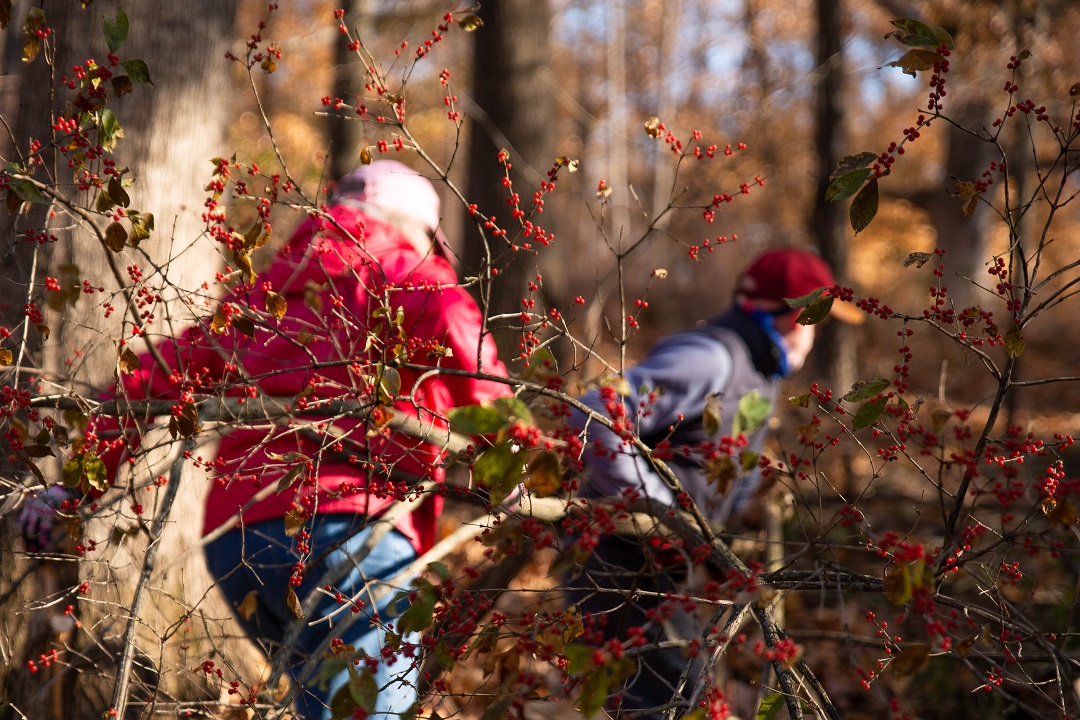Did you notice the trees turning green in March and breathe a sigh of relief that the world was waking up? If you did, you’re not alone. But what you may not know is that this early flush of green is a sign of the pervasive infestation of bush honeysuckle, a non-native species that’s spread throughout Missouri, harming the natural ecosystem.
Bush honeysuckle is a shrub that can grow to about 20 feet tall. It has yellowish-green leaves and white flowers in the spring that darken to yellow, eventually producing vivid red berries. Honeysuckle is typically the first plant to get leaves in the spring and the last to go bare in the autumn.
According to Missouri Botanical Garden, the plant is native to eastern Asia and was introduced to North America when botanical gardens in the US exchanged seed with gardens in Europe. In the 1960s, the Department of Agriculture began promoting bush honeysuckle for controlling erosion and improving the wildlife habitat (spoiler alert: it’s bad at both). It really became popular, though, for its ornamental properties. Now, it can be found all across Missouri, especially near urban areas.
OK, What’s the Big Deal?
By sprouting leaves early in the spring and persisting late into the fall, bush honeysuckle shades out native vegetation and causes a cascade of negative effects for native plants and wildlife. Missouri Botanical Garden calls it “one of the most destructive invasive species in the St. Louis region.”
When bush honeysuckle pops up in the woods, it harms the biodiversity of the area, eventually growing into a dense thicket that chokes out native plants. Gone unchecked long enough, and it could cause forests to die out — tree seedlings can’t compete with the shrubs, so there’s no new growth to replace older trees as they die.
A loss of plant biodiversity hurts insects (native plants provide the ideal habitat), amphibians (honeysuckle leaves break down and change the chemical composition of waterways, harming amphibian fertility), and birds (they eat the berries but get almost no nutritional value from them).

Before: Missouri creek overrun by bush honeysuckle.
One of the best illustrations of honeysuckle’s takeover in Missouri is how different generations view the forests, says Mike Saxton, supervisor of ecological restoration at Shaw Nature Reserve, a 2,400-acre extension of Missouri Botanical Garden. “People in their 60s remember the woods being super open,” he said. “Younger people, on the other hand, think of the woods as being dark, dense, and shady.”
Yikes. Is There Any Hope?
Yes! Shaw Nature Reserve has seen success with its diligent removal efforts. Long-term success requires a multi-step process of removing shrubs, planting native seeds, and prescribed burns, says Saxton, who’s been spearheading removal efforts.
In the past three years, 300 acres have been cleared of honeysuckle and other non-native plants. “We turned back the clock in a lot of areas. Visitors tell us it reminds them of woodlands when they were kids,” Saxton said.

After: Same Missouri creek after bush honeysuckle removal.
Much of the work at Shaw Nature Reserve is done by volunteers. During the dormant season (November through March or April), volunteers cut down honeysuckle plants. During the growing season (May through October), they collect and plant native seed, which is planted in the removal zones during January and February.
Great Rivers Greenway is also doing its part to combat the spread of bush honeysuckle. The public agency works in partnership with municipalities and other organizations to host removal events regionally and performs the maintenance needed for long-term sustainability, says Tom Schweiss, conservation program manager. Great Rivers Greenway is currently engaged in bush honeysuckle removal along the Fee Fee, Gravois, Meramec, Mississippi and St. Vincent greenways.
Many other organizations are diligently working to combat the problem. Missouri Botanical Garden unifies them for the biannual Honeysuckle Sweep for Healthy Habits campaign, a month-long spree of removal events in March and November. The first was in 2016.
“Organizations were already hosting volunteer work days,” said Allison Brown, Missouri Botanical Garden community programs coordinator. “We list all the different events on our website, so volunteers can go to one place to find all the opportunities available.”
In 2019, the Sweep included 80 events at 34 locations. Over 900 volunteers cleared 61 acres. That’s nearly double the acreage cleared in 2018 (35.75) and triple what was cleared in 2017 (20).
What Can We Do to Help?
Volunteering to help with Shaw Nature Reserve or with Great Rivers Greenway or during the Honeysuckle Sweep for Healthy Habits campaign is a great way to help. But you also need to look at your own backyard, suggests Schweiss. “Dig the plants up, then monitor the area, paying close attention in the spring and fall, when it’s easiest to spot honeysuckle,” he said.

Honeysuckle removal day with Great Rivers Greenway.
Replace any honeysuckle you remove with a native alternative. American plum, spicebush, and red buckeye are all good choices, says Cory Knoblauch, forester at Forest ReLeaf, a nonprofit dedicated to restoring and sustaining our urban forests. Missouri Botanical Garden’s plant finder is another good resource.
“It might seem overwhelming, but you don’t have to get rid of all of it at once,” Brown said. “Start with a small section of your yard, remove as much as you can, and replant that area before tackling another section.”
Perhaps the most important thing we can do, however, is heed the lessons honeysuckle has taught us. “We want to promote native plants and not have ornamental plants from all over the globe living in our backyard,” Saxton said. “It’s important that we prevent the next problematic species.”
Author: Stephanie Zeilenga is a regular contributor to Terrain Magazine.
Photos: Courtesy of Great Rivers Greenway.


Leave A Comment